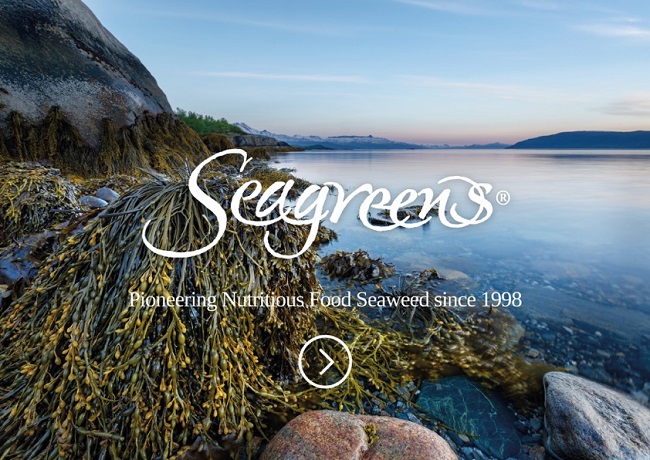Positive Health Online
Your Country

Why is Seaweed and Salt Better than Salt Alone?
listed in nutraceuticals, originally published in issue 243 - January 2018
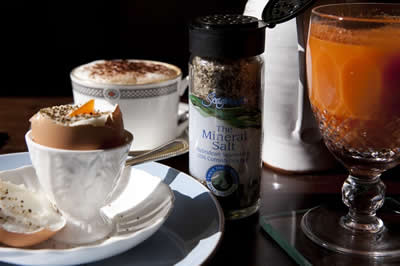
Seagreens® milled wild Wrack seaweed with natural sea salt, courtesy of Seagreens Trust
Salt is about 60% chloride and 40% sodium. Depending on the source, there is at most a few percent variation, with unprocessed sea salt, or ‘rock’ salt mined from land which was once a sea bed, containing tiny amounts of some 60 trace minerals.
Wild ‘Wrack’ seaweeds which are prolific around the Atlantic shores of the British Isles and Nordic region contain all the minerals and trace elements, balancing the intake of salt (sodium chloride) to such an extent that research has shown a 50% salt, 50% Wrack seaweed blend to be an antidote in rats fed 100% salt at levels causing heart failure.[1]
Mixing salt and seaweed ‘half and half’ retains the salty taste but adds complexity to flavour and broad nutritional value, with significant benefits to health.
This article focuses on the Wrack seaweed species (Ascophyllum, Fucus, and Pelvetia) because they are physically suitable for milling to a form very similar to rock salt or salt crystals. Also, they are nutritionally very dense. More delicate species such as Winged Kelp (Alaria esculenta) and Dulse (Palmaria palmata), when milled, form light flakes which blend quite well with salt flakes. Thus for every kind of salt, there is a suitable seaweed species for a blend.
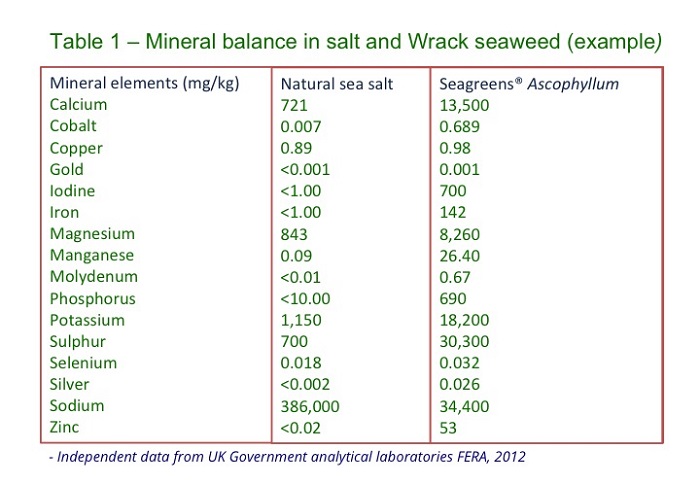
For a comprehensive list of nutrients in a 50% blend of sea salt and Seagreens® wild Ascophyllum choose The Mineral Salt at www.seagreens.co.uk/nutrition .
When this data is placed in the context of everyday land foods, its significance becomes very apparent. We know that since 1940 farmed meat lost 54% of its iron and 41% of its calcium, while vegetables lost on average 50% calcium, 25% iron and magnesium, and 76% copper and zinc.[2]
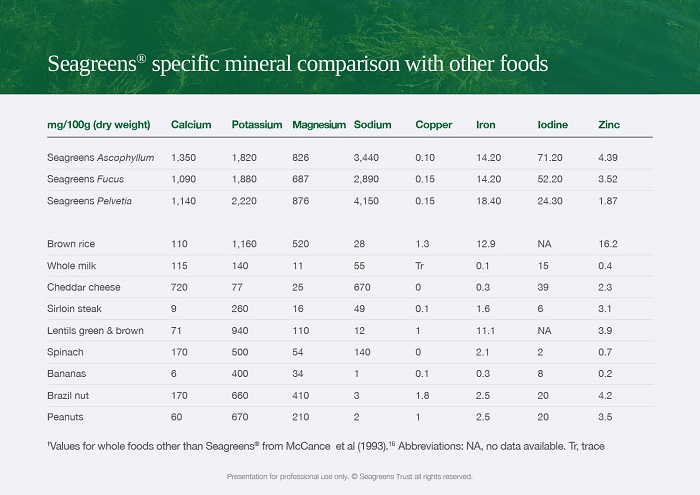
The other side of the coin is that during this period as never before, salt became ubiquitous in almost all prepared and processed foods, or the vast bulk of the daily diet. In his seminal review of the McCance and Widdowson (Government) data since 1940, researcher David Thomas wrote in 2002:
“The character, growing method, preparation, source and ultimate presentation of basic staples has changed significantly to the extent that trace elements and micronutrients have been seriously depleted. Concurrently there has been a precipitous change towards convenience and pre-prepared foods containing saturated fats, highly processed meats, and refined carbohydrates, often devoid of vital micronutrients yet packed with a cocktail of chemical additives including colourings, flavourings, fillers, binders and preservatives. Ongoing research clearly demonstrates a significant relationship between deficiences in micronutrients and physical and mental ill health.”
I have written about the rebalancing potential of the Wrack seaweeds elsewhere in this publication (www.positivehealth.com/author/simon-ranger) but it is relevant here to explore the nutritional profile beyond this narrow example of the mineral spectrum.
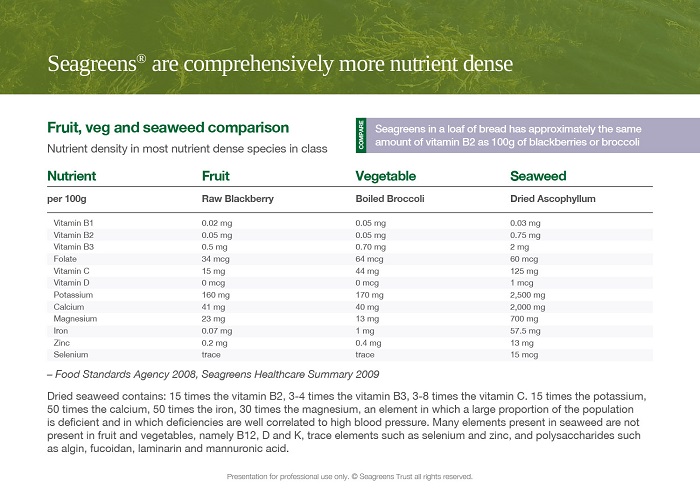
In the original UK Government sponsored research,[3] it was quite quickly discovered that Seagreens Wrack seaweeds could effectively replace salt as a preservative in meat and baked products, but better still, while salt kills bacteria leaving toxic waste, the seaweed stops the bacteria from growing - a far healthier alternative, not to mention the significant nutritional benefits.
The brown Wrack seaweeds also contribute the fifth ‘umami’ flavour characterized by depth and complexity, largely because they contain natural glutamic acid for which, it has been found, there are receptors in the digestive tract as well as the mouth - another reason why salt and seaweed is so much tastier than salt alone.
There may be special benefits in foods for the elderly. Umami has been shown to significantly increase salivation and taste, which in turn improves digestion. Loss of salivation in the elderly begins the downward spiral so that taste and therefore interest in food is lost. Seaweed mixed with salt, or as a ground food ingredient alone, can help restore appetite, weight gain, and general health.[4]
These are some of the advantages of replacing salt with seaweed, which I will expand on, but specific risks associated with excess salt[5] are legion, and generally salt is now held to be a significant factor in the onset of a range of conditions including the progenitors of heart disease, by far the major cause of death in the UK and similarly industrialized nations.
A study published in the British Journal of Cancer indicated the risk of stomach cancer in men consuming 12-15g salt per day to be double that of men on a low-salt intake of 4-6g per day. The risk to women was slightly more than half of that for men.[6] The UK Government in 2015 estimated a mean daily adult intake for men of 9.3g and for women of 6.8g, 80% of adults exceeding the recommended maximum of 6g per day.
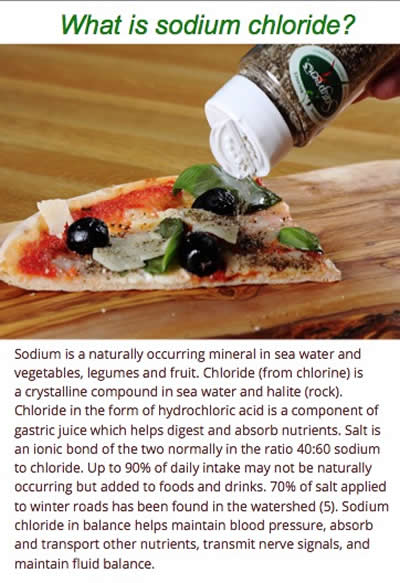
Also in 2015, a major international review of research into seaweed nutrition concluded that a range of different seaweed species could play a valuable role in the amelioration of the principal risk factors associated with cardiovascular disease - in addition to the reduction of dietary salt.[7]
The authors focus on the nutrient groups in seaweeds which make them “viable and important contenders for involuntary intervention strategies related to food manufacturing”, because they can help to ameliorate the effects of unhealthy plasma cholesterol levels, obesity, nutritional energy imbalances and inflammatory responses.
They highlight obesity, hypertension, endothelial dysfunction, diabetes, and disproportionate cellular free-radical production as the main diet-related risk factors leading to cardio-vascular diseases.
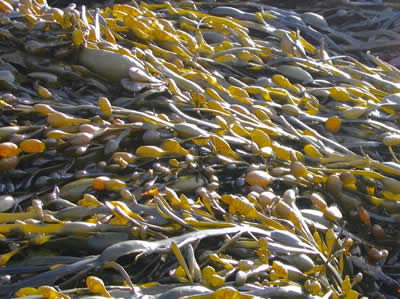
Seagreens® wild Wrack species Ascophyllum nodosum, courtesy of Seagreens Trust
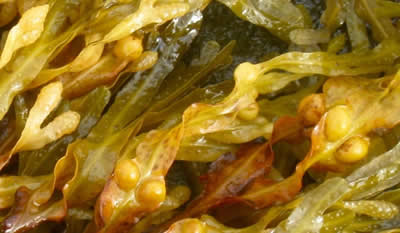
Seagreens® wild Wrack species Fucus vesiculosus, courtesy of Seagreens Trust
Independent studies on Seagreens® Wrack species since 2008 support the general findings of “particularly robust antioxidant suites, macro- and micro- nutritional elements, fatty acid and fibre content” with an unusually high ratio of soluble fibre which proves so valuable in digestion.
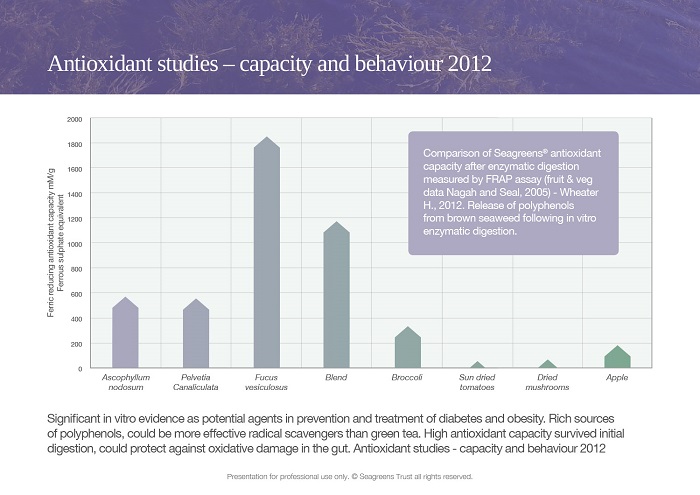
In 2017 the same authors reviewed how the consumption of seaweeds might affect brain health, concluding that “the moderate consumption of a diet fortified with macroalgae (seaweeds) have the capacity to help in the defence of human cognitive disorders such as dementia, Alzheimer’s, depression, bipolar diseases, and adverse conditions characterized by progressive neurodegeneration”.[8]
Currently, research and media interest is running ahead of a small but growing industry producing seaweeds for human consumption in western Europe.
Of some 35 species identified in these international reviews, only a handful of wild species is currently available which provide an independently certified nutritional, allergen-free and contaminant-free profile, are fully compliant with international food safety regulations, and have a track record of use in food and nutritional therapy for more than 15 years, supported by independent scientific research.
But the basis for their use in everyday eating, as well as in nutritional supplements and healthcare is now established.
In 2016 the Biodynamic Association introduced a comprehensive quality assurance scheme and standard for seaweed production with the Seaweed Health Foundation. The Nutritious Food Seaweed standard guarantees the consumer, for the first time, access to an independently certified and monitored nutritional profile.
There are now half a dozen harvesting enterprises in the British Isles and the Nordic region which can be depended on for nutritious food quality seaweed, and in addition to whole pieces of seaweed available in most health stores for use on the plate, seaweed ingredients are appearing in a many different everyday foods from Waitrose Duchy Organic Oaten Biscuits and Clearspring Pepper & Seaweed Oatcakes, to Exzo’s Clenzo Tea, Macacha’s Protein Drinks, or Sainsbury’s Sea Greens and Grain Broth.
Starting the day with your Bart® Seaweed & Salt Mill, or Seagreens® The Mineral Salt at breakfast, can lead to other easy to access seaweed ingredients or nutrition supplements which make up a daily intake of seaweed which - whilst unlikely to be on the level of the Japanese, whose traditional daily diet at least, contained up to 5 grams of dried seaweed - it is a start, and makes little change to the habit of a lifetime, the weekly shop.
On the other hand, additional benefits have been identified in more than 7 years of independent research conducted on Seagreens® wild seaweed species, including weight regulation through its effect on appetite,[9] nutrient absorption due to its natural prebiotic value in digestion,[10] and the value of other specific ‘seaweed’ nutrients such as iodine.[11]
According to research at Sheffield Hallam University, an ordinary breakfast including eggs on toast containing around 15 grams of Seagreens Wrack seaweed, caused obese men to lose weight with no adverse effect on nutrient uptake.[9] The Daily Telegraph trumpeted that “breakfasting on a slice of bread baked with ground up seaweed rather than salt, could help burn more calories than half an hour on a treadmill”.
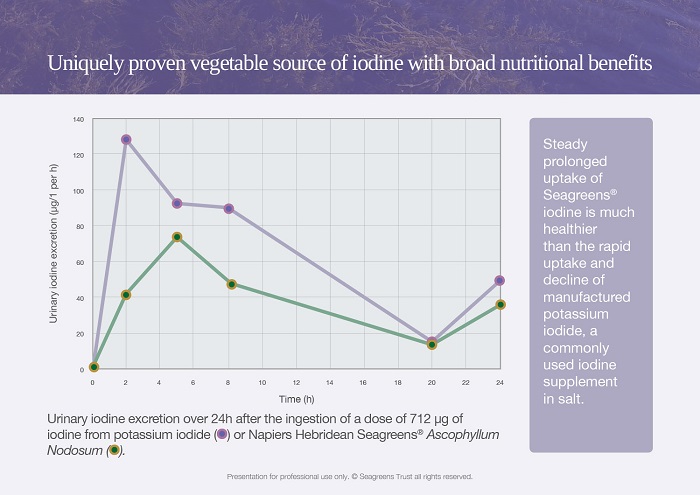
Also of topical concern is the level of iodine deficiency, particularly among women of child-bearing age and young people - certain seaweeds are safe natural sources of this micronutrient. In the UK more than 75% of pregnant women and teenage schoolgirls are iodine insufficient, and around half of students and babies.
Iodine contributes to normal thyroid, nervous system and cognitive function, normal growth in children, metabolism, and the maintenance of normal skin. Main dietary sources are meat and dairy products, but independent research has shown the ability of less than half a gram of Seagreens® Wrack seaweed in the daily diet can rectify iodine insufficiency with no adverse effect on thyroid hormones or function.[11]
In the graph, the rapid excretion of potassium iodide, an artificial chemical long used to fortify iodine in table salt (remember Saxa?) contrasts with the slower uptake of iodine from Seagreens® Ascophyllum over a prolonged period.
All the evidence - click on the above link - points to a raft of health benefits accruing not from the periodic addition of a piece of seaweed to a meal, however exotic, but from the daily inclusion of nutritious seaweed within our existing eating habits - and all to be taken of course, with a pinch of salt and seaweed!
References
1. Yamori, Y. et al. Dietary Prevention of Stroke and its Mechanisms in Stroke-Prone Spontaneously Hypertensive Rats. Journal of Hypertension vol. 4(3):S449-452. 1986.
2. Thomas, D.. Research compilation for ‘Overfed and Undernourished, London Conference on Obesity from The Mineral Depletion of Foods Available to us as a Nation (1940-2002) a Review of the 6th Edition of McCance and Widdowson. 2005.
3. Independent research at the Centre for Food Innovation, Sheffield established a blend of Seagreens® wild Wrack species as an effective salt replacement and natural preservative in manufactured foods. 2008-2011.
4. Sasano, T., Shizuko Satoh-Kuriwada, S., Noriaki, S. N.. The important role of umami taste in oral and overall health. Flavour, 4.10. 2015.
5. University of Minnesota. Road Salt In Lakes and Rivers, www.sciencedaily.com . February 20, 2009.
6. The Week. Health & Science section, Issue 43. 2004.
7. Cornish M. L., Critchley A. T., Mouritsen O. G.. A role for dietary macroalgae in the amelioration of certain risk factors associated with cardiovascular disease. Phycologia, Volume 54(6), 649-666. 2015.
8. Cornish M. L., Critchley A. T., Mouritsen O. G.. Consumption of seaweeds and the human brain. Journal of Applied Phycology, proceedings of the 22nd International Seaweed Symposium, Copenhagen. 2017.
9. Hall, A. C., Fairclough. A. C., Mahadevan, K., Paxman, J. R.. Ascophyllum nodosum enriched bread reduces subsequent energy intake with no effect on post-prandial glucose and cholesterol in healthy, overweight males. Journal of Appetite, 58:379-386. 2012.
10. Lyons, V. Seagreens® as a potential prebiotic and the role of probiotic bacteria in the production of nitric oxide in macrophages. MSc Thesis, Teeside University. 2012.
11. Combet E. Low-level seaweed supplementation proves iodine status in iodine-insufficient women. British Journal of Nutrition, 9:1-9. 2014.
Comments:
-
No Article Comments available
